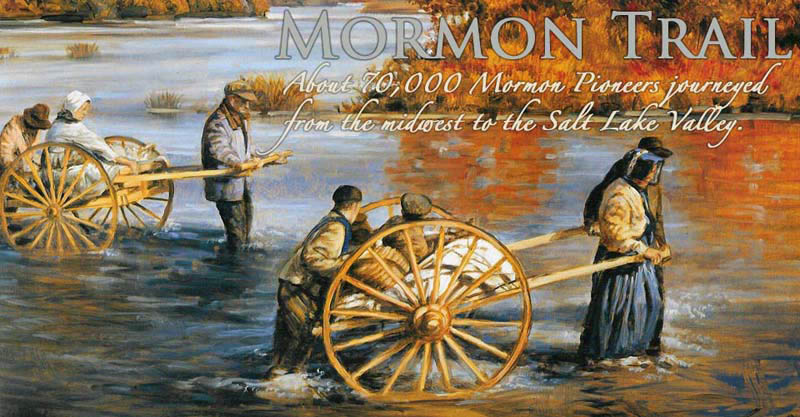Many of the early converts to the Church of Jesus Christ of Latter-day Saints suffered and sacrificed much in answering the call to gather to Salt Lake City, in the West. After already having suffered so much pain and persecution, and after the martyrdom of their leader, Brigham Young followed the Lord’s command to move the Saints to the West, where they hoped and believed no one would bother them. Here, in their own words, are some of their stories of crossing the plains to enter the Salt Lake Valley, of their time spent at Winter Quarters, of the beginnings of the Mormon Battalion, and of the suffering present in the handcart companies of 1856.
Winter Quarters and the Forming of the Mormon Battalion
 The first group of Saints traveling west stopped in Winter Quarters after leaders decided it was too late in the year to continue West. Just before turning to Council Bluffs, an order from the U.S. Army came to muster 500 young Mormon men to fight in the Mexican War. This left many families with no one to protect and care for them and was generally a huge trial for all involved. However, their service brought blessings few of them foresaw.
The first group of Saints traveling west stopped in Winter Quarters after leaders decided it was too late in the year to continue West. Just before turning to Council Bluffs, an order from the U.S. Army came to muster 500 young Mormon men to fight in the Mexican War. This left many families with no one to protect and care for them and was generally a huge trial for all involved. However, their service brought blessings few of them foresaw.
Job Smith tells of the trials of sacrificing 500 able-bodied young men to the United States Army for fighting in the Mexican War, running out of provisions and the effects of Black Scurvy, as well as his ingenuity in basket making to provide for his family.
Colonel Thomas Kane accompanied the Saints part of the way on their trek West after 500 of their young men were requisitioned by the government to fight in the Mexican War. His words offer a unique perspective of someon traveling with the Saints who was not of their faith.
Helen Kimball Whitney‘s account is thorough and touches on such interesting topics as the origins of the Mormon Battalion, the building up of Winter Quarters, the Saints’ dealings and relationships with the Native Americans, and general conditions and experiences of the time.
The Blessings Derived from the Service of the Mormon Battalion were listed by Brigham Young in his journal. It was expected by the U.S. Army that, in return for their service, the Mormons would be among the first settlers in California, thus reimbursing them for many of their wrongs. However, the Saints did not go on to California. Brigham Young also gives a reason for this.
Crossing the Plains
Joseph F. Smith, son of Joseph Smith’s brother, Hyrum Smith, relates his experiences of crossing the plains at the age of 9 with his mother. He talks of his mother’s faith in finding stolen oxen and having faith they will be healed when they go lame.
Mary Goble Pay gives her personal account of crossing the plains at the age of 13 with the John Hunt Company in 1856. She tells of hardships faced along the way, family members lost, and a promise Brigham Young gave her that her frostbitten feet would heal without requiring her to have more than her toes amputated. Though doctors doubted, Mary had faith that she would heal.
Personal Accounts of the Willie Handcart Company
 “No person can describe it, nor could it be comprehended or understood by any human living in this life, but those who were called to pass through it.” Jens Neilson, member Willie Handcart Company.
“No person can describe it, nor could it be comprehended or understood by any human living in this life, but those who were called to pass through it.” Jens Neilson, member Willie Handcart Company.
Peter Howard McBride recounts his family’s trip from Scotland and then West with the Willie Handcart Company when he was only 6 years old. He struggled in the harsh conditions, and his father died along the way, but they made it successfully to the Salt Lake Valley.
Agnes Caldwell Southworth tells of her mother’s ingenuity in helping her family cross the plains and of their rescue near the end of their journey. Agnes was 9 when they crossed the plains in 1856.
A Willie Handcart Company Journal Excerpt relates the faith these Saints had and records a promise given to them from President Franklin D. Richards that they would succeed in their trials, with the help of God.
The Rescue of the Handcart Companies in 1856
Ephraim Hanks was an able frontiersman who was called to help in the rescue of the Saints stranded in the late handcart companies of 1856. He went at personal risk, as did all the rescuers, and relates his experiences of being able to find them and miraculously bring them fresh buffalo meat, which they desperately needed in their starving states.
The End of the Journey in the Salt Lake Valley
Howard Egan recounts his feelings of security upon entering the Salt Lake Valley.
End of the Journey. The first Saints arrived in the Salt Lake Valley on July 24, 1847. President Brigham Young rode out with a small group of men to survey the valley. Eleven years later the distressed handcart companies arrived late in the year 1856 after suffering unimaginable trials. All who made this journey made immense sacrifices to help build the Kingdom of God. Words from President Hinckley remind Church members of their continuing responsibilities.
Twitter •


 Watch a video about the restoration of the gospel on lds.org
Watch a video about the restoration of the gospel on lds.org